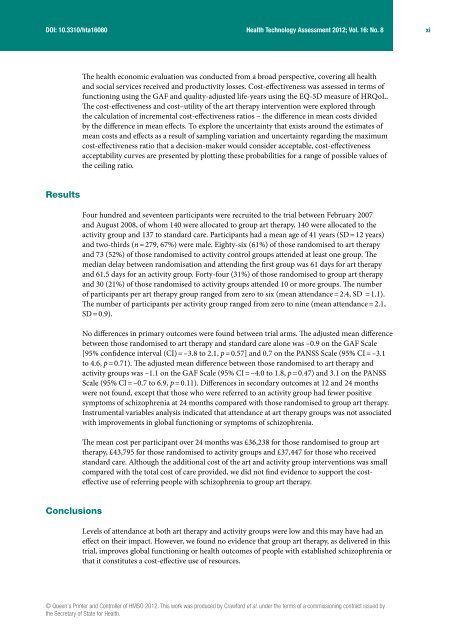a randomised controlled trial (MATISSE). - ResearchGate
a randomised controlled trial (MATISSE). - ResearchGate
a randomised controlled trial (MATISSE). - ResearchGate
Create successful ePaper yourself
Turn your PDF publications into a flip-book with our unique Google optimized e-Paper software.
DOI: 10.3310/hta16080<br />
Results<br />
Conclusions<br />
Health Technology Assessment 2012; Vol. 16: No. 8<br />
The health economic evaluation was conducted from a broad perspective, covering all health<br />
and social services received and productivity losses. Cost-effectiveness was assessed in terms of<br />
functioning using the GAF and quality-adjusted life-years using the EQ-5D measure of HRQoL.<br />
The cost-effectiveness and cost–utility of the art therapy intervention were explored through<br />
the calculation of incremental cost-effectiveness ratios – the difference in mean costs divided<br />
by the difference in mean effects. To explore the uncertainty that exists around the estimates of<br />
mean costs and effects as a result of sampling variation and uncertainty regarding the maximum<br />
cost-effectiveness ratio that a decision-maker would consider acceptable, cost-effectiveness<br />
acceptability curves are presented by plotting these probabilities for a range of possible values of<br />
the ceiling ratio.<br />
Four hundred and seventeen participants were recruited to the <strong>trial</strong> between February 2007<br />
and August 2008, of whom 140 were allocated to group art therapy, 140 were allocated to the<br />
activity group and 137 to standard care. Participants had a mean age of 41 years (SD = 12 years)<br />
and two-thirds (n = 279, 67%) were male. Eighty-six (61%) of those <strong>randomised</strong> to art therapy<br />
and 73 (52%) of those <strong>randomised</strong> to activity control groups attended at least one group. The<br />
median delay between randomisation and attending the first group was 61 days for art therapy<br />
and 61.5 days for an activity group. Forty-four (31%) of those <strong>randomised</strong> to group art therapy<br />
and 30 (21%) of those <strong>randomised</strong> to activity groups attended 10 or more groups. The number<br />
of participants per art therapy group ranged from zero to six (mean attendance = 2.4, SD = 1.1).<br />
The number of participants per activity group ranged from zero to nine (mean attendance = 2.1,<br />
SD = 0.9).<br />
No differences in primary outcomes were found between <strong>trial</strong> arms. The adjusted mean difference<br />
between those <strong>randomised</strong> to art therapy and standard care alone was –0.9 on the GAF Scale<br />
[95% confidence interval (CI) = –3.8 to 2.1, p = 0.57] and 0.7 on the PANSS Scale (95% CI = –3.1<br />
to 4.6, p = 0.71). The adjusted mean difference between those <strong>randomised</strong> to art therapy and<br />
activity groups was –1.1 on the GAF Scale (95% CI = –4.0 to 1.8, p = 0.47) and 3.1 on the PANSS<br />
Scale (95% CI = –0.7 to 6.9, p = 0.11). Differences in secondary outcomes at 12 and 24 months<br />
were not found, except that those who were referred to an activity group had fewer positive<br />
symptoms of schizophrenia at 24 months compared with those <strong>randomised</strong> to group art therapy.<br />
Instrumental variables analysis indicated that attendance at art therapy groups was not associated<br />
with improvements in global functioning or symptoms of schizophrenia.<br />
The mean cost per participant over 24 months was £36,238 for those <strong>randomised</strong> to group art<br />
therapy, £43,795 for those <strong>randomised</strong> to activity groups and £37,447 for those who received<br />
standard care. Although the additional cost of the art and activity group interventions was small<br />
compared with the total cost of care provided, we did not find evidence to support the costeffective<br />
use of referring people with schizophrenia to group art therapy.<br />
Levels of attendance at both art therapy and activity groups were low and this may have had an<br />
effect on their impact. However, we found no evidence that group art therapy, as delivered in this<br />
<strong>trial</strong>, improves global functioning or health outcomes of people with established schizophrenia or<br />
that it constitutes a cost-effective use of resources.<br />
© Queen’s Printer and Controller of HMSO 2012. This work was produced by Crawford et al. under the terms of a commissioning contract issued by<br />
the Secretary of State for Health.<br />
xi
















